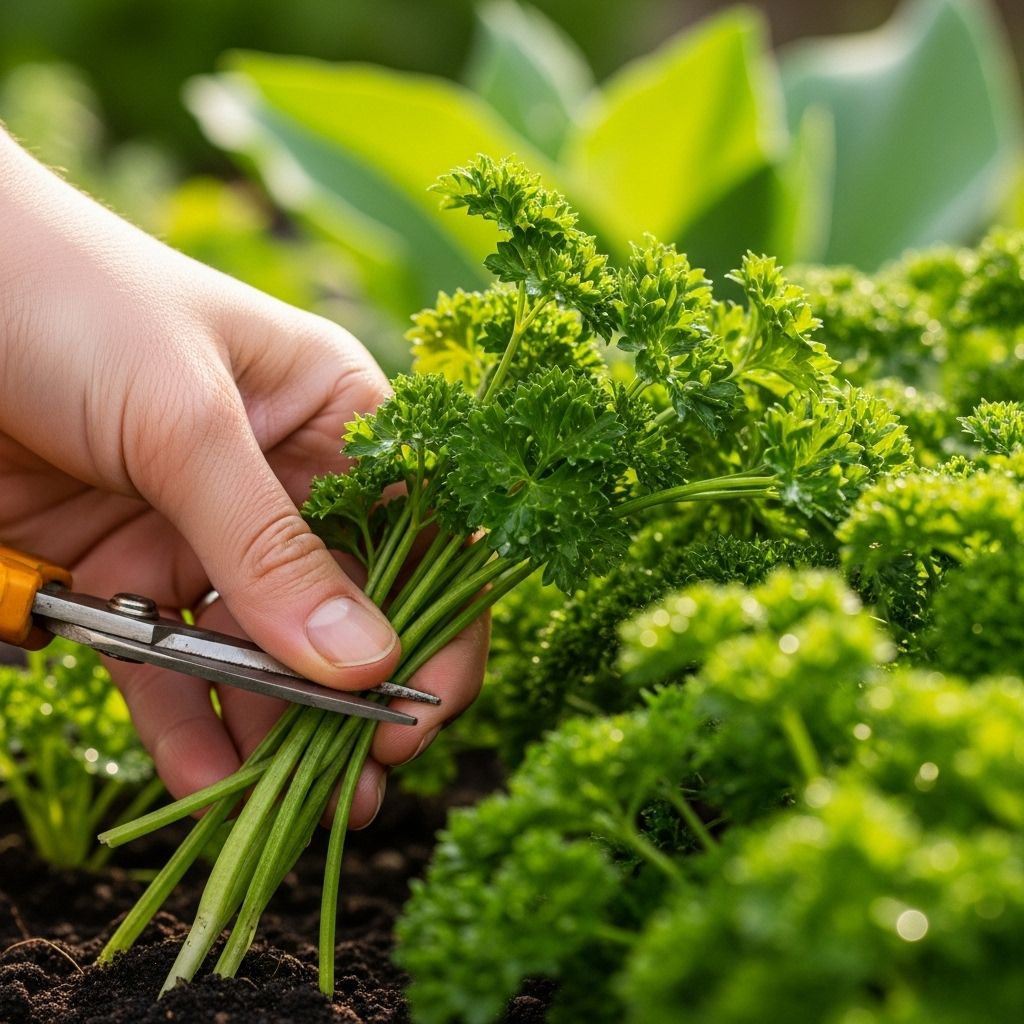How to Harvest Parsley: Expert Tips for Abundant, Flavorful Leaves
Trimming outer stems and proper storage unlock consistently vibrant herb flavors.

How to Harvest Parsley: A Comprehensive Guide for Gardeners
Parsley (Petroselinum crispum) is one of the most popular culinary herbs, valued for its unmistakable flavor, vibrant green leaves, and versatility in the kitchen. Whether you grow curly or flat-leaf varieties, mastering the right harvesting techniques ensures your plants thrive and your dishes are packed with fresh taste. This article details the complete process for harvesting parsley, storing it, and maximizing your harvest for a continual supply throughout the year.
Why Harvest Parsley Correctly?
Proper harvesting encourages healthy regrowth, keeps your plants producing for a longer season, and keeps flavors at their peak. Incorrect methods can cause stunted plants or bitter leaves, decreasing the quality and quantity of your harvest.
When Should You Harvest Parsley?
Timing is key for optimal flavor and plant health. Parsley is a biennial (lives two years), but most gardeners grow it as an annual since the best leaves are produced in the first year. Follow these guidelines:
- Wait 70-90 days after sowing to begin harvesting. Your plants should have several full stems with at least three leaf segments before you start cutting.
- In temperate regions, harvest year-round. In most climates, the main parsley season stretches from spring to fall.
- Harvest in the early morning for maximum flavor. The essential oils are most concentrated before the sun gets hot.
- Regular harvesting promotes new growth. Instead of infrequent large harvests, picking a few stems often keeps the plant productive and delays bolting (flowering).
Step-by-Step Guide: How to Harvest Parsley
Use these techniques for best results:
- Identify mature outer stems. The outer leaves mature first. Look for stems with at least three segments.
- Cut stems at the base. With clean scissors or garden shears, snip stems where they meet the main plant base. This encourages the plant to divert energy into producing new shoots.
- Avoid cutting the inner (center) stems. These are the newest growths and will be your next harvests.
- Do not remove more than one-third at a time. Overharvesting can stress the plant and reduce regrowth potential.
- Continue repeat harvesting every 2–3 weeks as the plant grows back.
Follow these additional maintenance tips:
- If plants begin to flower in the second year, leaves will turn bitter. For best taste, replant each year.
- Curlier and flat-leaf parsley have the same harvest protocols—flat-leaf (Italian) is often preferred for cooking due to its robust flavor.
Harvesting for Different Uses
| Harvest Type | Best Method | Recommended Use |
|---|---|---|
| Fresh Garnish | Immediate harvest of a few leaves | Add at the end of cooking, salads, or as a topping |
| Cooking Ingredient | Harvest full stems, rinse, and chop | Soups, stews, and warm dishes |
| Preserving | Large batch harvest, then dry or freeze | Winter storage, spice blends |
How to Store Fresh Parsley
Fresh parsley loses flavor quickly if not stored properly. Here are the best methods to maintain freshness:
- In water: Place harvested stems in a glass or jar of water (like a bouquet) in the fridge. Change water every few days—keeps for up to a week.
- Refrigerator storage: Rinse, pat dry, wrap leaves in a slightly damp paper towel, and seal in a plastic bag or container. Use within 5–7 days for maximum flavor.
- For best flavor and color, add parsley towards the end of the cooking process.
Drying Parsley for Long-Term Use
Drying is an excellent way to preserve an abundant yield for months:
- Rinse and thoroughly dry sprigs to prevent mold.
- Bundle stems and hang them upside down in a warm, dark, well-ventilated area. Optionally, use a paper bag over the leaves to keep out dust.
- Allow 7–15 days for complete drying depending on environment.
- If using a food dehydrator, choose an air-only setting or very low heat to preserve flavor.
- Crumble dried leaves and store in an airtight container, away from sunlight.
- Use dried parsley within 2–3 years for best flavor. Always check for signs of mold before use.
Freezing Parsley: Retain Fresh Flavor
Freezing preserves the green color and much of the bright flavor lost in drying. Here’s how:
- Chop washed parsley and spread on a baking tray. Flash-freeze, then transfer to a freezer bag or container.
- Alternatively, portion chopped parsley into ice cube trays, fill with water or olive oil, and freeze. Drop cubes directly into recipes as needed.
- Frozen parsley retains much more flavor than commercial dehydrated forms.
Encouraging Parsley to Regrow After Harvesting
Parsley is naturally resilient and will regrow after you cut it, especially in the first year. For continual harvest:
- Do not cut the center stalk. Always leave the youngest, center leaves untouched during each harvest.
- Use a staggered harvest approach, taking only part of each plant at a time and rotating between plants if you have several.
- Parsley typically takes two to three weeks to fully regrow after a harvest.
- Maintain consistent soil moisture and fertilize lightly after heavy harvesting for best recovery.
Signs Your Parsley Needs Harvesting or Replacement
- Bitter taste, yellowing, or bolting (sending up a flower stalk) usually signals it is nearing the end of its productive life.
- First-year leaves are sweetest and most tender. Second-year leaves, after winter, often turn tougher and more bitter—ideally, sow new seeds each season for premium quality.
Common Mistakes to Avoid When Harvesting Parsley
- Overharvesting—taking too much at once can weaken the plant.
- Cutting the center stalk—slows regrowth dramatically.
- Neglecting regular harvests—parsley that isn’t routinely picked may go to seed early, which shortens the harvest window.
- Improper storage—leads to rapid wilt or flavor loss.
Integrating Fresh and Preserved Parsley Into Your Cooking
- Add fresh parsley at the end of cooking for vibrant color and the most pronounced flavor.
- Dry or frozen parsley can be stirred into warm dishes but use more dried than fresh, as it’s less potent.
- Garnish soups, pastas, salads, meats, and vegetables for a finishing touch.
Parsley Varieties and Harvesting Differences
The two most cultivated types—Curly leaf and Flat leaf (Italian)—can both be harvested in the same way. Flat-leaf parsley is generally preferred for culinary use because it’s easier to chop and its flavor is bolder.
| Curly Leaf | Flat Leaf (Italian) |
|---|---|
| Decorative, often used as a garnish More delicate flavor | Preferred by chefs Robust taste, easier to chop |
Growing Tips for a Continual Parsley Harvest
- Plant new seeds each year for the most productive and best-tasting crop.
- Grow in sun to part shade. Too much summer heat can cause bolting, while frost is tolerated and can improve color.
- Good soil drainage and even moisture yield healthier foliage.
- Harvest regularly to keep the herb producing and prevent early seeding.
Frequently Asked Questions (FAQs)
Q: Does parsley regrow after cutting?
A: Yes! Parsley will regrow after cutting, especially if you harvest only the outer stems and avoid the center stalk. This cut-and-come-again method provides repeated harvests through the season.
Q: Does parsley come back every year?
A: Parsley is a biennial, but in its second year, it quickly sends up a flower stalk and leaves become less desirable. Most gardeners treat parsley as an annual and sow new plants each year for best results.
Q: Why is my parsley plant turning yellow?
A: Yellowing can be due to overwatering, waterlogged soil, or sometimes root rot. Always check soil drainage and avoid letting roots sit in soggy earth.
Q: How many times can I harvest a parsley plant?
A: You can harvest many times—as often as every 2–3 weeks if done incrementally. Avoid removing more than one-third of the plant at each session to guarantee ongoing yield.
Q: Should I harvest parsely leaves individually or by the stem?
A: Cut entire stems at the base rather than picking individual leaves. This ensures best plant regrowth and more uniform production.
Q: Can I harvest after the plant has bolted?
A: It is not recommended; leaves after bolting are usually bitter. Consider pulling up the old plant and sowing a fresh crop for quality leaves.
Key Takeaways for a Bountiful Parsley Harvest
- Harvest regularly and take from the outside stems to promote regrowth.
- Store fresh parsley in water or loosely wrapped in the fridge to retain flavor and texture.
- Dry or freeze parsley for use all year long – both methods lock in flavor for culinary use.
- Replace plants yearly for sweetest, most tender greens and steady yields.
References
Read full bio of Srija Burman












